
|
|
Name: Porta Augusta Date: Etruscan 700 BCE-100 BCE Country: Italy Material: Stone Style: Anticipates use of the Roman arch |

|
|
Name: Reconstruction of an Etruscan Temple Date: Etruscan 700-100 BCE Material: Stone Style: Resembles Greek temples, post-and-lintel, entablature similar to frieze, "tuscan order" columns simliar to doric order |

|
|
Name: Apollo Artist: Vulca Dates: Etruscan 700-100 BCE Country: Italy Material: Terra Cotta Style: Archaic smile, clothed in robe, dynamic pose rather than perfectly balanced, energetic |

|
|
Name: Dancers and Diners Location: Tomb of the Triclinium Dates: Etruscan 700-100 BCE Country: Italy Style: Dark men, light women, women more integrated than in Greek world, animated, happy, banquet, colorful |

|
|
Name: Burial Chamber Location: Tomb of the Reliefs Dates: Etruscan 700-100 BCE Country: Italy Material: Stone Style: Resembles a home, made in relief and painted, fittings formed of stucco - slow-drying type of plaster |
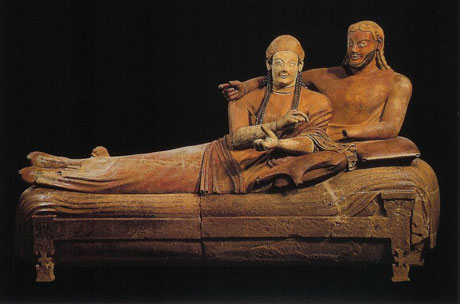
|
|
Name: Sarcophagus from Cerveteri Dates: Etruscan 700-100 BCE Country: Italy Material: Terra Cotta Style: Archaic smiles, pointed beards, braided hair (all Greek features), buried together, marriage bed or dining couch, happy afterlife |

|
|
Name:Head of a Man (Lucius Junius Brutus) Dates: Etruscan 700-100 BCE Country: Italy Material: Bronze, eyes of painted ivory Style: portrait, painted ivory, very realistic, early look at what Roman art would look like |

|
|
Name: Aulus Metellus Dates: Roman Republic 509 BCE - 27 CE Country: Italy Material: Bronze Style: not naked, means business, toga and leather boots (typical of Roman senator), known as The Orator, persuasive |

|
|
Name: Pont du Gard Dates: Roman Republic 509 BCE - 27 CE Country: France Material: Stone Style: Roman round arches, Romans bring amenities to cities they take over, brought water to the citizens of Nimes |

|
|
Name: Temple, perhaps dedicated to Portunus Dates: Roman Republic 509 BCE - 27 CE Country: Italy Material: Stone Style: street level has changed, Ionic, pediment, axial alighnment, engaged columns - built into the wall, pseudo peripteral - looks peripteral but not
|

|
|
Name: Augustus of Primaporta Dates: Early Empire 27 - 96 CE Country:Italy Material: Marble Style: Propaganda, probably a god b/c barefoot, authoritative, never ages, contrapposto |

|
|
Name: Ara Pacis Augustae (Altar of Augustan Peace) Dates: Early Empire 27 - 96 CE Country: Italy Material: Marble Style: Processional friezes on exterior reflect Ionic frieze on the Parthenon, however, the figures are real and in real scenes rather than idealized |

|
|
Name: Imperial Precession Location: Relief on south side of the Ara Pacis Dates: Early Empire 27 - 96 CE Country: Italy Material: Stone Style: Relief, real people rather than idealized people, true scenes, deep relief |

|
|
Name: Gemma Augustea Dates: Early Empire 27 - 96 CE Country: Italy Material: Stone Style: Propaganda, low relief, lots of gods imagery and stuff that makes the guy with the halo awesome |

|
|
Name: Plan and Reconstruction Drawing, House of the Silver Wedding Dates: Early Empire 27-96 CE Country: Italy Style: Roman style home, atriums, gardens, |
|
|
|
Name: Peristyle garden Location: House of the Vettii Dates: Early Empire 27 - 96 CE Country: Italy Style: Set up to be seen from entrance, straight on, open roof |

|
|
Name: Wall painting in the "Ixion Room" Location: House of the Vettii Dates: Early Empire Country: Italy Style: Paintings apperar to recede into the wall, illusion |

|
|
Name: Inititation Rites of the Cult of Bacchus Location: Villa of the Mysteries Dates: Early Empire 27 - 96 BCE Country: Italy Material: Wall Painting Style: Encrustacean - painting along bottom edge, look like covered in marble, 2nd style - illusion of depth, stage in wall |

|
|
Name: Cityscape Location: A bedroom in the House of Publius Fannius Synistor Dates: Early Empire 27 - 96 CE Country: Italy Material: Wall painting Style: 2nd style, attempt on perspective, colorful, theater masks signal that might be inspired by theater |
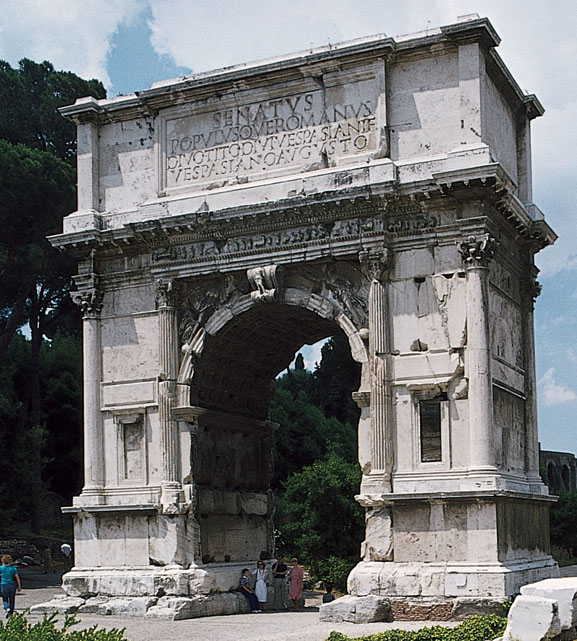
|
|
Name: Arch of Titus Dates: Early Empier 27 - 96 CE Country: Italy Material: Concrete and white marble Style: held a lost statue, entablature reads that senators and people of rome erectred the arch, roman round arch, efficient way of building with concrete |

|
|
Name: Spoils from the Temple of Solomon Location: Relief in the passageway of the Arch of Titus Dates: Early Empire 27 - 96 CE Country: Italy Material: Stone Style: Shows victory over Jerusalem, looting from temple, parade, real scene, looks like how they did running through the temple |

|
|
Name: Colosseum Dates: Early Empire 27 - 96 CE Country: Italy Material: Stone Style: Order (from top to bottom) Tuscan, Ionic, Corinthian, Corinthian pilasters |

|
|
Name: Young Flavian Woman Dates: Early Empire 27 - 96 CE Country: Italy Material: Marble Style: Flavian hair, idealized, hard lines in jaw and nose contrast smooth lips and eyes |

|
|
Name: Basilica Ulpia Dates: High Empire 96 - 192 CE Country: Italy Material: Style: basilica - a large rectangular building with an extensive interior space, adaptable for a variety of governmental functions, court of law |
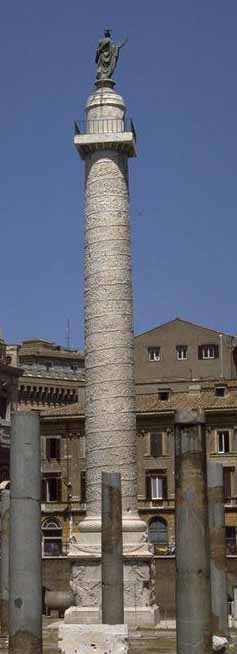
|
|
Name: Column of Trajan Dates: High Empire 96 - 192 CE Country: Italy Material: Marble Style: Propaganda, displays Trajan as wonderful, stories kept small so important figures can be large, pictorial narratives of the Dacian campaigns |

|
|
Name: Pantheon Dates: High Empire 96 - 129 CE Country: Italy Material: Style: temple to the Olympian gods, street level has changed, rotunda - circular room |

|
|
Name: Dome of the Pantheon Dates: High Empire 96 - 129 CE Country: Italy Style: oculus - central opening (lets light in), eyes drawn upwards by coffers - sunken panels |

|
|
Name: The Canal (Canopus) Dates: High Empire 96 - 129 CE Country: Italy Material: Stone Style: Varying semicircular and straight entablature, Greek caryatids replicated, pleasant and happy |

|
|
Name: Equestrian statue of Marcus Aurelius Dates: High Empire 96 - 129 CE Country: Italy Material: Bronze Style: Mistaken as Constantine so not melted down, curly hair and beard matches Greek philosophers, rhetorical speech lookin', horse didn't look too small compared to rider (at least not for their time) |

|
|
Name: Commodus as Hercules Location: Esquiline Hill Dates: High Empire 96 - 129 CE Country: Italy Material: Marble Style: References to Hercules = Nemean lion skin and head, the club, the golden apples from Garden of the Hesperides, propaganda, looks like father |
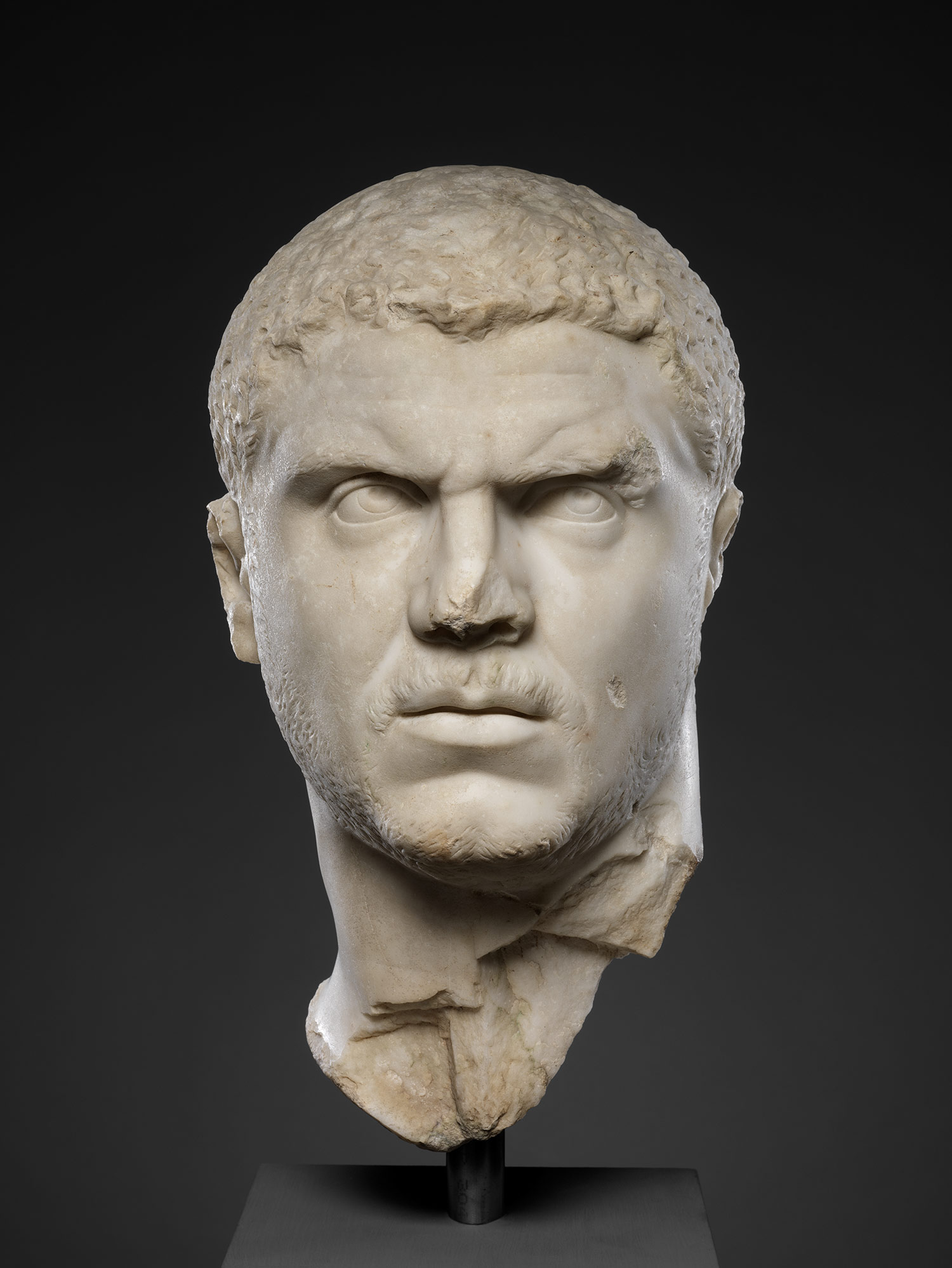
|
|
Name: Caracalla Dates: Late Empire 192 - 476 CE Country: Italy Material: marble Style: Emperor, military iron-fisted guy, mean, X across face |

|
|
Name: Baths of Caracalla Dates: Late Empire 192 - 476 CE Country: Italy Style: Gift from emperor, symmetrical, used furnace heaters below the surface for showers |
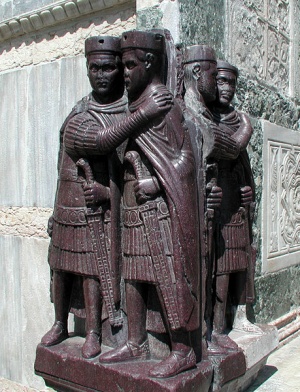
|
|
Name: The Tetrarchs Dates: Late Empire 192 - 476 CE Country: Italy Material: Porphyry Style: rule of four, all identical but younger are shaven and older have beards, geometrical shapes and uneven proportions, propaganda - we're united |
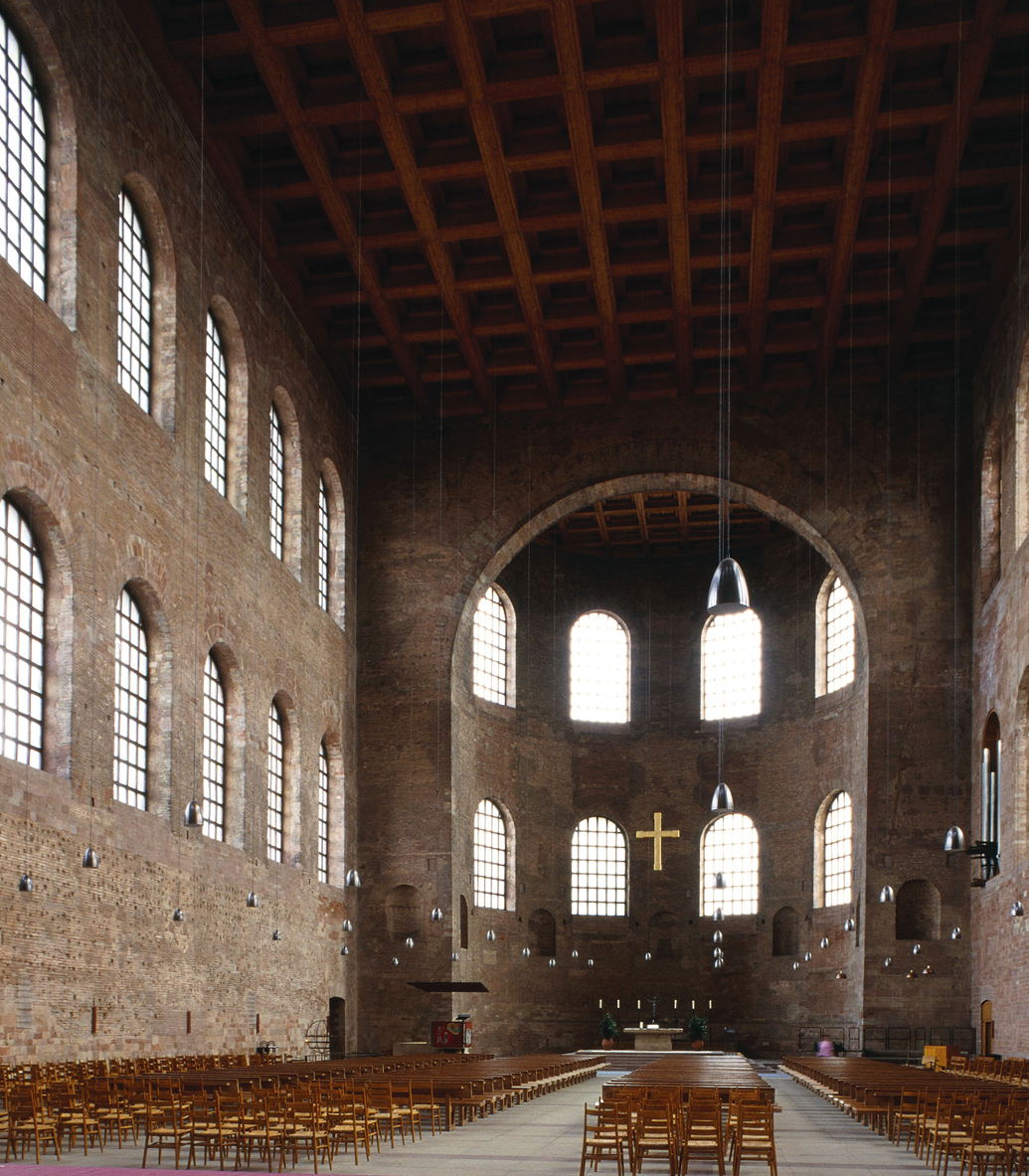
|
|
Name: Audience Hall of Constantius Chlorus (The Basilica) Dates: Late Empire 192 - 476 CE Country: Germany Material: Stone Style: later used for Christian church, directional focus, heating from underground, windows make the building look bigger (larger than life) |

|
|
Name: Audience Hall of Constantius Chlorus (The Basilica) Dates: Late Empire 192 - 476 CE Country: Germany Material: Brick Style: large size and simple plan, imposing buildings that impress |

|
|
Name: Arch of Constantine Dates: Late Empire 192 - 476 Country: Italy Material: Stone Style: covered in sculpture, not all in same time, transferred Roman values of strength, courage, and piety |

|
|
Name: Hadrian Hunting Boar and Sacrificing to Apollo; Constantine Addressing the Roman People in the Roman Forum Location: Arch of Constantine Dates: 192 - 476 Country: Italy Material: Stone Style: Relief, show Constantine's victory and symbolize his strength and generosity, relief along bottom follows tetrachal art, figures pushed into foreground, later picked up by the Christian church, secular |

|
|
Name: Constantine the Great Location: Basilica of Maxentius and Constantine Dates: 192 - 476 CE Country: Italy Material: Marble Style: combines Roman portraiture with tetrachal abstract qualities, heavy jaw, hooked nose, and jutting chin made symmetrical and then eyes and eyebrows made to match, giving a sense of perfection and strength |

|
|
Name: Good Shepherd, Orants, and Story of Jonah Location: Catacomb of Saints Petro and Marcellino Dates: Early Christian 1st - 4th century Country: Italy Material: paint on ceiling Style: Good shepherd in center (Jesus), Jonah and the whale story told in lunettes, people later interpreted this story as Christ's death and resurrection, orants (good christians) in between |
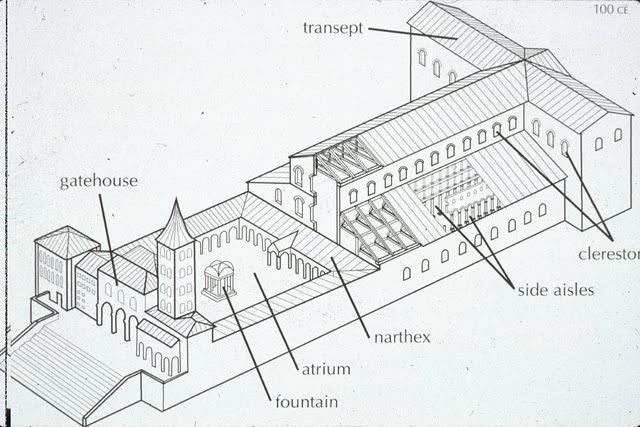
|
|
Name: Old Saint Peter's basilica Dates: Imperial Christian 4th - 6th century Country: Rome Style: Christians believed St. Peter buried here, study the layout |

|
|
Name: Church of Santa Sabina Dates: Imperial Christian 4th - 6th century Country: Italy Material: Brick Style: follows Old St. Peter plan, inside spectacular |

|
|
Name: Interior, Church of Santa Sabina Dates: Imperial Christian 4th - 6th century Country: Italy Style: Spolia - materials from old buildings are recycled, round arches on columns, marble, it's all pretty and shit |

|
|
Name: Church of Santa Costanza Dates: Imperial Christian 4th - 6th century Country: Italy Style: Central plan, tall rotunda with ambulatory - encircling barrell-vaulted passage, |

|
|
Name: Sarcophagus of Junius Bassus Dates: Imperial Christian 4th - 6th century Country: Italy Material: Marble Style: several different stories from the bible, split into two registers using columns and entablatures, christ in center on top and bottom, top as emperor, bottom as earthly |
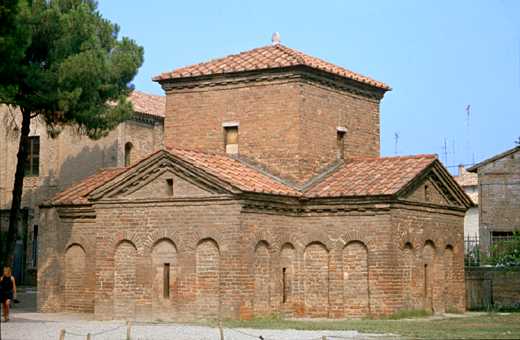
|
|
Name: Oratory of Galla Placidia Dates: Imperial Christian 4th - 6th century Country: Italy Material: brick Style: oratory - small chapel, cruciform - cross shape, one of earliest surviving Christian structures in Ravenna, inside symbolizes walk into the supernatural |

|
|
Name: The Good Shepherd Location: Oratory of Galla Placidia Dates: Imperial Christian 4th - 6th century Country: Italy Material: mosaic Style: Christianity now legal and state religion so Jesus made in mosaic, the richest known medium of wall decoration, Jesus now looks more like Jesus we know today as compared to the earlier Good Shepherd, he's now an adult with purple and gold robes, staff is a cross, halo |